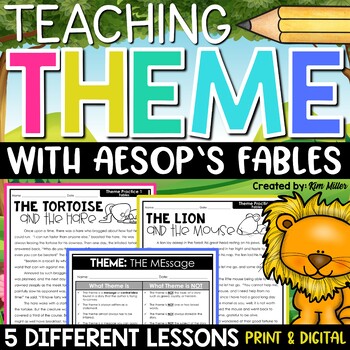Teaching Theme with Aesop's Fables Finding Theme Worksheets Graphic Organizers
- PDF
- Google Apps™
- Easel Activity

What educators are saying
Also included in
- Help your students easily find the theme of a story or poem with this bundle of teaching theme resources! This download comes with a variety of activities that will help your students learn how to identify the themes and topics of fables, short stories, and poems. By using these theme posters, readiPrice $19.60Original Price $24.50Save $4.90
Description
Do your students struggle to find the theme of a story? Theme can be a difficult skill for students to master but it doesn't have to be! Teaching theme with fables makes finding themes in literature a little easier. In this resource, students will learn how to explain how the theme is conveyed through morals, lessons, and key details in fables. Students will quickly and easily be able to determine the message or central idea found in a story that the author is trying to convey.
Eliminate the confusion!
Finding the theme of a story can be confusing for students. This resource includes an introduction that first teaches students the difference between THEME and TOPIC. Students will explore a variety of themes and topics found in literature. Being able to identify the difference between the two is the first step to mastering theme!
This resource includes:
- Theme Classroom Poster
- Introduction Lesson: Why is theme so confusing? The Difference Between Topic, Theme, Fable, and Moral
- Common Themes in Literature (Reference Chart)
- Common Topics in Literature (Reference Chart)
- Who was Aesop?
- Fable #1: The Tortoise and the Hare
- Fable #2: The Lion and Mouse
- Fable #3: The Ant and the Grasshopper
- Fable #4: The Town Mouse and the Country Mouse
- Fable Writing Activity with Planning Guide
- Digital Google Option
- TpT Easel Activity Digital Option
- Answer Keys
Each engaging fable activity includes:
- a finding the theme guide for students
- story mapping activity (problem, solution, moral, theme)
- 24 multiple choice and open-ended questions assessing reading comprehension, theme, and the action of the characters
⭐ Print and go or assign digitally! Each printable activity is also included in a digital format using Google Slides with assessments in Google Forms.
These activities are perfect for:
- whole group instruction
- small groups
- independent desk work
- assessments
- homework
- sub plans, and so much more!
The best part?
Your students will quickly learn how to describe in-depth the characters, settings, and events in each fable as they draw on specific details in the text. They will get right to work identifying key details from the fables to determine the central ideas or themes found in the text.
Teachers like you said…
⭐⭐⭐⭐⭐ I am currently using this with both my 3rd and 4th grade ESL reading groups. They have such a hard time determining the theme in stories. The short, simple fables take off some of the pressure of struggling to read longer, harder texts and allow the students to really focus on the theme (or moral, or lesson...) Thank you for creating this resource to help both myself and my students. – Lori P.
⭐⭐⭐⭐⭐ My students struggle with theme more than others so I am always on the lookout for extra activities. This resource is perfect! I love the added history piece explaining who Aesop was since my students are older they appreciate that and it increased their attention to the fables - they became more than just children's stories. I thought the distinction between moral and theme was well done and helped clarify that for my students. Thank you so much! – Karen G.
⭐⭐⭐⭐⭐ These classic fables were a hit with my 4th graders. I really liked how each fable included three pages of extension work inviting critical thinking, with the same formatting for each of the two fables (as we know, kids love a predictable format). I definitely recommend this resource for anyone doing a unit study on fables. – Andrea B.
In this one convenient resource, you can…
- have ready-to-go activities that will help your students master finding the theme of a story.
- use these pre-made theme activities as sub plans when you need to take a day (or week) off!
- print and go or assign digitally - includes everything you need to teach THEME anytime during the year!
Note: Detailed answer keys have been added to make it easier for you to discuss the questions with your students. These activities were intended to be used whole group or in a small group setting. Unless your students are comfortable with finding the theme of a story, they will likely struggle while completing these activities independently.
Supports Common Core Standards (CCSS)
RL.3.2, RL.3.3, W.3.3
RL.4.2, RL.4.3, W.4.3
RL.5.2, RL.5.3, W.5.3
You may also like…
Compare Contrast Themes & Topics Across Cultures Passages & Graphic Organizers
Teaching Theme Posters by Topic | Themes in Literature
Teaching Theme Using Quotes Activities, Worksheets, and Graphic Organizers
Teaching Theme Reading Passages Activities Using Close Reading Strategies
Click ★HERE★ to follow my store and be notified when new products are uploaded.
All new resources are 50% off for the first 24 hours!
⭐ Please note: If you are having difficulty with this file, please visit the FAQs section, submit a help ticket, or ask me a question on the Q&A tab before leaving feedback.
Copyright © Kim Miller (A Love of Teaching)
Permission to copy for single classroom use only.
Please purchase additional licenses if you intend to share this product.







